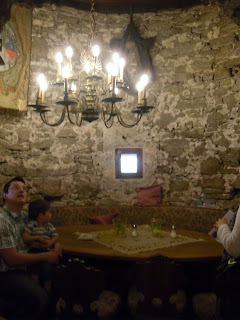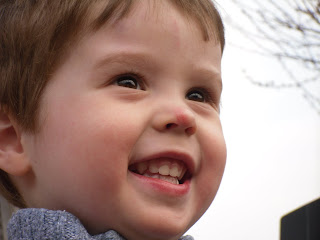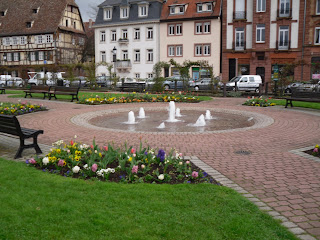Clausen, a sleepy little village in the rolling hills of
the Rhineland-Palatinate Forest in Germany. Population approximately 1,500.
Our home from 1996-2000.
We joined a choir when we moved to Clausen to help us with our German. It didn't matter that most of the people were 30 years older than us. They took us under their wings and loved us.
They introduced us to their children and grandchildren and we became friends with generations of these families in the village.
In this picture the men of the choir welcomed me back a few weeks ago with a song which, always makes me cry. They put me in a circle and sang it to me,
"Why have you come back when you will leave again? You have taken my heart and I will never be the same."
We would sit at these tables after choir practice and chat to learn German.
As we began to understand the language, there were recurring words in our conversations. Something of great importance to them that they were desperate to communicate to us.
Giftgas
Lager
Wald
American base im Clausen
Russians
I went home and pulled out my dictionary. "MAC," I yelled, "They were trying to tell us that there was an American base in Clausen that stored chemical weapons."
"Those bases are top secret, "he replied.
We went to choir practice the next week with tons of questions. One of the ladies said that she knew something was up when cars with Russian license plates used to cruise through the village. She knew it wasn't good if the Russians were looking around in Clausen.
We asked for them to show us what they were talking about.
They say it was the summer of 1961 when the base in Clausen was made for conventional ammunition stockpiles. Six years later, the Americans were storing deadly chemical weapons in this little village unbeknownst to them.
The entrance to this base was down a road in Clausen that I had never been on. I thought it was a dead-end road.
I was shocked when I saw a well -maintained road at the edge of the forest. Not the normal "wandering paths" I walked on. We followed our friends 2 miles up the road through a little valley to the remains of this base. We saw control towers, dog kennels, and enormous igloo style sod-covered bunkers with giant ventilation shafts that stored the chemical weapons.
Our German friends explained they all knew there was a secret base in Clausen. Afterall, there were no signposts for this base and that is unusual in itself. There was a secret going on, but they were unaware of what was it was.
The chemical weapons were transported out of Clausen as secretly as they had been brought into the village.
From what I can find out, they were supposedly taken to Johnston Atoll, 700 miles southwest of Hawaii in the Pacific, where toxins are burned.
I was even more devastated to learn that these weapons were so dangerous that had an accident occured, the entire village of Clausen and surrounding thousands of villages would have been wiped out. What if the situation were reversed and weapons that could have destroyed most of Maine were stored in Morrill where I grew up?
We used to be able to go right onto what was the base and look at the huge ventilation shafts, bunkers, etc. but, it is now owned by a private citizen and people are not permitted on what was the
Clausen Giftgas Lager anymore.
It says:
"In Rememberance
Up until 1990 chemical weapons were stored in this forest, for a long time they threatened a million people.
Thank God they never were used and in the summer of 1990 were transported to be destroyed.
God , friend of our life, we thank you. Protect us from destroying your creation."
We have to find a way to bring peace to the world for the sake of our children and our grandchildren.
Let's reach out to other cultures and people who are different.
Learn about their cultures and history.
It is the beginning of understanding and it can start one person at a time.
For Mac and me we say,
"Let there be peace on earth and let it begin with me."
song by Sy Miller and Jill Jackson





















































